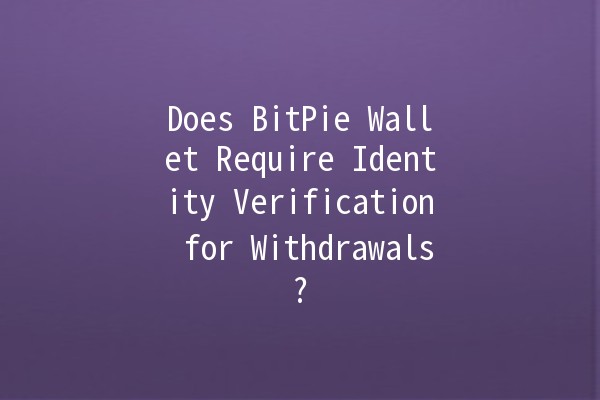
In the everevolving landscape of cryptocurrency, wallets serve as essential tools for managing your digital assets. As crypto transactions become more widespread, the question of security and regulations becomes paramount. One critical aspect users often inquire about is whether they need to undergo identity verification when withdrawing funds from their wallets, particularly in the case of BitPie Wallet. This article delves into this topic, offering valuable insights and practical advice for users.
Understanding BitPie Wallet
BitPie Wallet is a widely used cryptocurrency wallet that enables users to store, send, and receive various digital currencies. As a noncustodial wallet, it allows users to maintain control over their private keys, providing an extra layer of security. As cryptocurrency regulations continue to shift globally, wallet providers, including BitPie, have implemented various policies that may affect the user experience, particularly regarding identity verification.
What is Identity Verification?
Identity verification is a process that requires users to provide personal identification information to confirm their identities. This can include submitting documents such as passports, driver's licenses, or other forms of identification. The necessity for identity verification can stem from regulatory compliance requirements aimed at preventing fraud, money laundering, and other illicit activities.

Does BitPie Wallet Require Identity Verification for Withdrawals?
The answer to this question can vary depending on several factors, including regulations in your specific country, the amount being withdrawn, and the overall compliance policies of the Wallet. In many cases, smaller withdrawals may not necessitate verification, while larger amounts, particularly those that exceed certain thresholds, may prompt a verification request.
CountrySpecific Regulations
Different jurisdictions have their own laws regarding cryptocurrency transactions. For example, in countries with stringent regulations regarding antimoney laundering (AML) and know your customer (KYC) protocols, identity verification may be mandatory for all transactions, including withdrawals from BitPie Wallet. Conversely, in regions where crypto regulations are more relaxed, users might enjoy more freedom with less stringent verification processes.
Withdrawal Limits
Typically, wallets like BitPie Wallet set withdrawal limits based on various factors, including whether a user has completed identity verification. For example:
Unverified Users: May face lower withdrawal limits (e.g., 0.1 BTC per transaction).
Verified Users: Can withdraw larger amounts without restrictions (e.g., 5 BTC or more).
This tiered approach allows the wallet provider to manage risk while still accommodating users who prefer to maintain a level of anonymity.
Practical Tips to Manage Your BitPie Wallet
Explanation: Adding an extra layer of security through twofactor authentication (2FA) is essential for protecting your wallet.
Example: By enabling 2FA, any time you attempt to withdraw funds, you will need to enter a code sent to your mobile device, making unauthorized transactions more difficult.
Explanation: Regularly updating your wallet software ensures you benefit from the latest security patches and features.
Example: BitPie Wallet can release updates that improve security or user experience. By keeping your app updated, you reduce the risk of vulnerabilities that could affect your funds.
Explanation: Keeping track of your transactions can help you detect any unauthorized activities promptly.
Example: Set a reminder to review your transaction history weekly. If you spot a transaction you don't recognize, you can report it immediately.
Explanation: Before withdrawing a large sum, research the current regulatory environment in your jurisdiction.
Example: If your country recently enacted new KYC regulations, consider verifying your identity preemptively to avoid delays when withdrawing larger sums.
Explanation: Always access your wallet using a secure, private internet connection to avoid potential hacking attempts.
Example: Avoid using public WiFi to access your BitPie Wallet. Instead, connect through a secure home network or a trusted VPN service to enhance security.
Common Questions About BitPie Wallet and Identity Verification
Identity verification is not mandatory for all users, but it is often required for larger transactions based on the wallet's policies and local regulations.
Typically, governmentissued identification such as a passport or driver's license is required. Additional documents, like proof of residence, may also be requested depending on compliance protocols.
The verification process can vary, typically ranging from a few minutes to 48 hours, depending on the wallet's operational efficiency and the volume of verification requests.
If you choose not to complete the verification process, you may face limitations on withdrawals, smaller transaction limits, or even account suspension until verification is completed.
Often, smaller withdrawals may not require verification, but this largely depends on the specific policies set by BitPie Wallet and local laws governing cryptocurrencies.
Trying to bypass identity verification is not advised and can lead to account suspension or legal repercussions. Always follow the wallet's guidelines to ensure compliance with regulations.
Making Informed Decisions
, while BitPie Wallet may not require identity verification for every withdrawal, it is crucial for users to understand the implications of their transactions, especially in light of evolving regulations. By staying informed and following best practices for security, users can enjoy the full benefits of their BitPie Wallet while minimizing risks.
Investing time in understanding identity verification processes and staying updated on regulations can lead to a smoother experience when navigating cryptocurrency withdrawals. Always prioritize security, conduct thorough research, and stay compliant with your local laws for a safer crypto journey.

